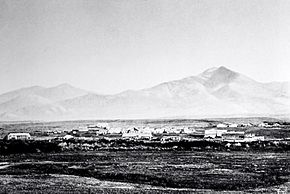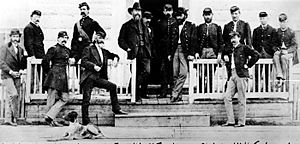Fort Ellis facts for kids
Quick facts for kids Fort Ellis |
|
|---|---|
| Gallatin County, east of Bozeman, Montana | |

Fort Ellis, July 1871
|
|
| Type | Fort |
| Site information | |
| Condition | No Remnants |
| Site history | |
| Built | August 27, 1867 |
| Built by | U.S. Army |
| Materials | Logs |
| Demolished | August 2, 1886 (decommissioned) |
| Events | Marias Massacre Washburn-Langford-Doane Expedition Great Sioux War of 1876-77 |
| Garrison information | |
| Garrison | U.S. Army 2nd Cavalry, 7th Infantry |
Fort Ellis was an important United States Army fort. It was built on August 27, 1867. You could find it east of what is now Bozeman, Montana. Soldiers from Fort Ellis took part in many big events and campaigns. The fort was closed down in 1886.
Contents
History of Fort Ellis
The War Department built Fort Ellis to help and protect settlers. These settlers were moving into the Gallatin Valley in Montana. The fort was named after Colonel Augustus van Horne Ellis. He was a brave soldier who died in 1863 during the Civil War.
The fort had soldiers from the 2nd US Cavalry Regiment and the 7th Infantry Regiment. These groups formed the fort's garrison, which means the troops stationed there. Another nearby fort, Fort Elizabeth Meagher, was closed after Fort Ellis was built.
Fort Ellis's Role in the West
Fort Ellis was a key spot during the Indian Wars of the 1800s. It was also a starting point for exploring the area that is now Yellowstone National Park.
In January 1870, Major Eugene M. Baker led soldiers from the Second Cavalry. They were involved in an event with the Piegan tribe near the Marias River in Montana. Later, in April 1876, Colonel John Gibbon left Fort Ellis with 400 soldiers. They were part of a big summer campaign during the Great Sioux War of 1876–77. Troops from Fort Ellis also helped in the Nez Perce War in 1877.
Exploring Yellowstone from Fort Ellis
The fort also provided military escorts for many important trips into the Yellowstone region. In 1870, Lieutenant Gustavus Cheyney Doane and five cavalrymen went with Henry D. Washburn and other civilians. This trip was called the Washburn-Langford-Doane Expedition. Lieutenant Doane also joined other expeditions in 1871 and 1875. He even went on a difficult exploration of the Snake River in 1876.
Fort Ellis and Bozeman
Like many frontier forts, the soldiers at Fort Ellis had a mixed relationship with the nearby town of Bozeman. Bozeman was about 3 miles west of the fort. In December 1867, soldiers from the 13th US Infantry destroyed buildings in town. These buildings were selling alcohol to the soldiers, which was causing problems.
Even though there were some issues, the people of Bozeman liked the money the fort brought in. The fort's contracts and soldier payroll helped the town's economy.
Commanding Officers at Fort Ellis

Here are some of the officers who were in charge of Fort Ellis:
- 1867 – 1869 Captain R. S. LaMotte
- 1869 – 1870 Colonel A. G. Brackett
- 1870 – 1873 Major Eugene M. Baker
- 1873 – 1876 Major N. B. Sweitzer
- 1876 – 1877 Captain D. W. Benham
- 1877 – 1880 Major J. S. Brisbin
- 1880 – 1881 Lieutenant Colonel A. J. Alexander
- 1881 – 1884 Major D. S. Gordon
- 1884 – 1886 Major G. G. Hunt
Closing of Fort Ellis
Fort Ellis was built on good farmland. Many settlers in Bozeman wanted the fort to close. This was especially true after the Northern Pacific Railroad arrived in 1883. The civilians wanted to use the fort's 26,000 acres of land for farming and homes.
Even though the fort might have stayed open longer, Generals Sherman and Sheridan decided to close it. They needed to save money and found support from the local people to close this fort. Fort Ellis was officially closed on August 2, 1886. The Army left the fort by the end of August 1886.
After the fort closed, its parade ground was used by the Montana Militia for a while. In 1924, many of the fort's buildings were still standing. This included a two-story house that was once the Commanding Officer's quarters. Today, that building has been updated. It is now used by the Agricultural Experimental Station, which is run by Montana State University.

